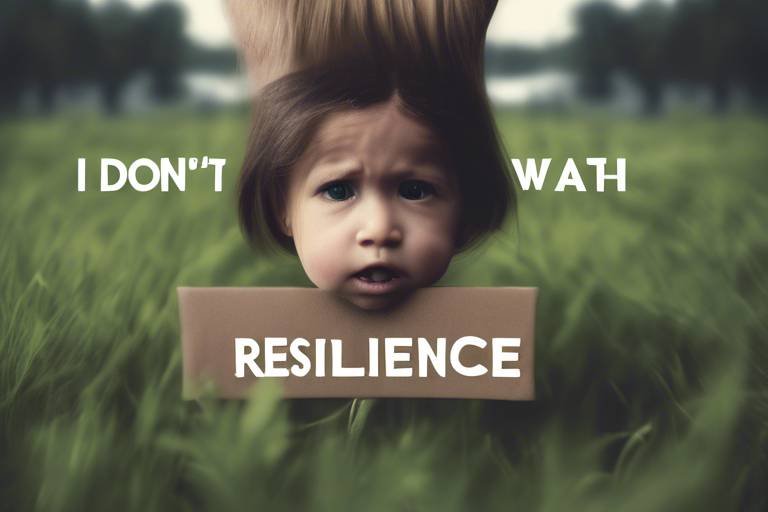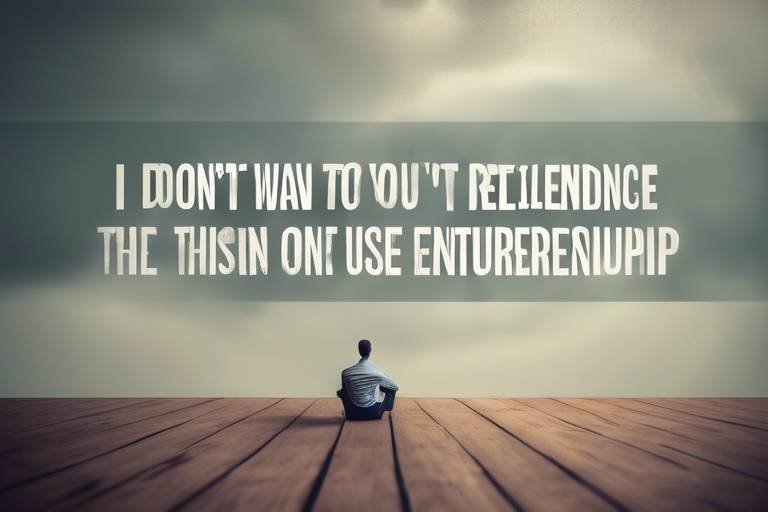How Does Resilience Fight Against Burnout?
In today's fast-paced world, burnout has become a common affliction, affecting not just our productivity but also our overall well-being. But what if I told you there’s a powerful antidote to this overwhelming fatigue? Enter resilience—the mental reservoir of strength that helps people cope with stress and overcome challenges. Think of resilience as a rubber band; it stretches under pressure but always returns to its original shape. This article dives deep into how resilience acts as a buffer against burnout, providing insights into practical strategies and psychological mechanisms that can enhance both your well-being and workplace productivity.
Resilience is not just a trait you either have or don’t have; it’s a skill that can be developed over time. Imagine it as a muscle: the more you work on it, the stronger it gets. When faced with adversity, resilient individuals are better equipped to bounce back, adapt, and even thrive. This ability not only helps in personal struggles but also plays a crucial role in professional settings. So, how does building resilience help in fighting burnout?
Firstly, resilient individuals tend to have a more positive outlook on life. They possess the ability to reframe negative experiences into learning opportunities, which significantly reduces feelings of helplessness and hopelessness often associated with burnout. By focusing on growth rather than failure, they cultivate a mindset that embraces challenges, making them less likely to succumb to stress. Furthermore, resilience encourages a sense of agency—an understanding that we can influence our circumstances, which is vital when dealing with the pressures of work and life.
Moreover, resilience fosters strong social connections. When you’re feeling overwhelmed, having a supportive network can make all the difference. Resilient people often seek help from friends, family, or colleagues, which not only alleviates feelings of isolation but also provides new perspectives on the challenges they face. Just like a sturdy bridge that can withstand heavy traffic, strong relationships can support us through turbulent times, reinforcing our ability to cope with stress.
Lastly, resilience promotes healthy coping strategies. Instead of turning to unhealthy habits like excessive drinking or procrastination, resilient individuals are more likely to engage in activities that promote well-being. They might practice mindfulness, exercise, or pursue hobbies that bring joy and relaxation. By adopting these positive coping mechanisms, they can effectively manage stress and reduce the risk of burnout.
In summary, resilience is a multifaceted skill that plays a pivotal role in combating burnout. By fostering a positive mindset, cultivating strong social connections, and adopting healthy coping strategies, we can enhance our resilience and, in turn, protect ourselves from the debilitating effects of burnout. As we delve deeper into the various aspects of resilience throughout this article, remember that it’s never too late to start building your resilience and reclaiming your well-being.
- What is resilience? Resilience is the ability to bounce back from adversity, adapt to stress, and maintain a positive outlook.
- How can I develop resilience? You can develop resilience through practices like mindfulness, building social connections, and engaging in positive coping strategies.
- What are the symptoms of burnout? Common symptoms include emotional exhaustion, irritability, cognitive difficulties, and physical fatigue.
- Why is resilience important for mental health? Resilience helps individuals cope with stress, reduces the risk of burnout, and promotes overall well-being.

The Importance of Resilience
This article explores the concept of resilience and its role in combating burnout, providing insights into practical strategies and psychological mechanisms that enhance well-being and workplace productivity.
Understanding resilience is crucial for recognizing its impact on mental health. But what exactly is resilience? In simple terms, resilience is the ability to bounce back from adversity, stress, or trauma. Think of it as a rubber band; it stretches and bends under pressure, but it returns to its original shape once the pressure is released. This characteristic is not just a trait that some people are born with; it can be developed and strengthened over time.
Resilience plays a significant role in both personal and professional contexts. In our fast-paced world, where challenges and stressors are abundant, having a resilient mindset can be the difference between thriving and merely surviving. When individuals possess resilience, they are better equipped to handle life's ups and downs, which ultimately leads to improved mental health and overall well-being.
Moreover, resilience is linked to higher levels of productivity in the workplace. Employees who can navigate stress effectively tend to be more engaged, creative, and motivated. They are less likely to succumb to burnout, which can lead to absenteeism and decreased job performance. In fact, studies have shown that resilient individuals are not only more likely to stay in their jobs but also to advance in their careers.
So, how can we cultivate resilience? Here are a few key areas to focus on:
- Building strong relationships: Having a support system can provide emotional comfort during tough times.
- Maintaining a positive outlook: Emphasizing optimism can help reframe challenges as opportunities for growth.
- Setting realistic goals: Achieving small, manageable goals can boost confidence and create a sense of accomplishment.
In summary, resilience is not just a buzzword; it's a vital skill that enhances our ability to cope with stress and recover from setbacks. By prioritizing resilience, we can foster a healthier, more productive environment both personally and professionally.
Recognizing the signs of burnout is the first step towards recovery. This section outlines common symptoms and how they manifest in individuals, helping readers to identify when they might be experiencing burnout.
Emotional symptoms of burnout can significantly affect daily life. This subsection discusses feelings such as anxiety, irritability, and a sense of hopelessness that often accompany burnout.
Cognitive symptoms can hinder decision-making and creativity. This part focuses on how burnout affects concentration, memory, and problem-solving abilities.
Physical symptoms often manifest as fatigue and sleep disturbances. This section explains how burnout can lead to chronic exhaustion and other health issues.
Developing resilience is a proactive approach to preventing burnout. This section outlines various strategies and practices that individuals can adopt to strengthen their resilience.
Mindfulness and self-care are essential components of resilience. This section discusses techniques for incorporating mindfulness practices and self-care routines into daily life to combat stress.
Mindfulness can enhance emotional regulation and awareness. This subsection highlights methods for practicing mindfulness, such as meditation and deep breathing exercises.
A consistent self-care routine can prevent burnout. This section provides tips for creating a personalized self-care plan that includes physical, emotional, and social well-being activities.
Q: What is resilience?
A: Resilience is the ability to recover from setbacks, adapt to change, and keep going in the face of adversity.
Q: How can I build resilience?
A: You can build resilience by fostering strong relationships, maintaining a positive outlook, and setting realistic goals.
Q: What are the signs of burnout?
A: Common signs of burnout include emotional exhaustion, irritability, fatigue, and decreased performance at work.

Identifying Burnout Symptoms
Recognizing the signs of burnout is the crucial first step towards recovery. Burnout isn't just about feeling tired; it’s a complex state that can manifest in various ways, affecting your emotional, cognitive, and physical well-being. If you're feeling overwhelmed, detached, or just plain exhausted, it might be time to take a closer look at what your body and mind are telling you.
Burnout can creep up on you like a thief in the night, often starting with subtle signs that can easily be dismissed. It’s like a slow leak in a tire; at first, it seems insignificant, but if left unchecked, it can lead to a complete blowout. So, what should you be on the lookout for? Here are some common symptoms that can help you identify if you're experiencing burnout:
- Emotional Symptoms: Feelings of anxiety, irritability, and a sense of hopelessness are common emotional indicators of burnout. You might find yourself snapping at colleagues or feeling an overwhelming sense of dread about your work.
- Cognitive Symptoms: Burnout can cloud your thinking. You may notice a decline in your concentration, memory, and problem-solving abilities. It’s as if your brain is running on a slow internet connection—everything takes longer, and frustration builds.
- Physical Symptoms: Chronic exhaustion is perhaps the most telling physical symptom of burnout. You might feel like you’re dragging yourself through the day, and sleep disturbances may leave you feeling more fatigued than before.
Understanding these symptoms is vital because they are your body’s way of signaling that something isn’t right. When you ignore these signs, you risk not only your productivity but your overall health. It’s essential to take action before burnout becomes a full-blown crisis.
In a workplace context, burnout can lead to decreased performance and engagement. Employees may start to feel disconnected from their tasks, leading to a cycle of negativity that can be hard to break. Recognizing these symptoms early can help you intervene before it spirals out of control.
So, if you find yourself nodding along to any of these symptoms, don’t panic! Awareness is the first step, and it’s never too late to make changes. The next part of our journey will focus on how to build resilience, which can serve as your shield against the onslaught of burnout.
Q: What is burnout?
A: Burnout is a state of emotional, physical, and mental exhaustion caused by prolonged and excessive stress. It can occur when you feel overwhelmed, emotionally drained, and unable to meet constant demands.
Q: How can I tell if I'm experiencing burnout?
A: Look for signs such as chronic fatigue, irritability, reduced performance, and feelings of hopelessness. If you notice these symptoms persisting, it may be time to seek help.
Q: Can burnout be prevented?
A: Yes! Building resilience through mindfulness, self-care, and maintaining a healthy work-life balance can significantly reduce the risk of burnout.
Q: What should I do if I think I’m burned out?
A: Consider reaching out to a mental health professional, taking time off work, and implementing self-care strategies to help manage your symptoms.

Emotional Symptoms
When we talk about burnout, it's essential to recognize that it doesn't just wear you down physically; it can also take a significant toll on your emotional health. Imagine you're a balloon, full of air and ready to float, but the weight of stress and exhaustion keeps pulling you down. This is how emotional symptoms of burnout can feel—heavy, suffocating, and draining. Feelings of anxiety often creep in, making even the simplest tasks feel overwhelming. You might find yourself constantly worrying about your performance or fearing that you’re not doing enough, which only adds to the stress.
Moreover, irritability can become your new norm. You may snap at colleagues or loved ones over trivial matters, and later, you might feel guilty about it. It’s as if you’ve become a tightly wound spring, ready to explode at the slightest provocation. This irritability often stems from a sense of hopelessness that accompanies burnout. You might find yourself thinking, “What’s the point?” or “I’ll never get through this.” Such thoughts can be debilitating and can lead to a downward spiral if not addressed promptly.
In addition to these feelings, burnout can also lead to a state of emotional numbness. You might notice that activities you once enjoyed, like spending time with friends or engaging in hobbies, no longer bring you joy. It’s as if the colors of your life have faded to gray. This emotional disconnection can make it challenging to maintain relationships, both personal and professional, further isolating you during a time when connection is crucial.
To illustrate the emotional symptoms of burnout, consider the following table that summarizes common feelings experienced by individuals undergoing burnout:
| Emotional Symptoms | Description |
|---|---|
| Anxiety | Persistent worry and nervousness about work and personal life. |
| Irritability | Increased frustration and anger over minor issues. |
| Hopelessness | Feeling as if nothing will improve or change. |
| Emotional Numbness | A lack of feeling or interest in activities that once brought joy. |
Recognizing these emotional symptoms is the first step towards healing. By acknowledging how you feel, you can take proactive measures to address the underlying issues contributing to your burnout. Remember, it’s okay to seek help, whether through professional counseling or by simply talking to someone you trust. After all, you don’t have to face this alone.

Cognitive Symptoms
Cognitive symptoms of burnout can be particularly insidious, creeping into your daily life and distorting your ability to think clearly. Imagine trying to navigate a foggy road; everything feels hazy, and your usual sharpness is dulled. This is exactly how burnout affects your cognitive function. You might find yourself struggling with concentration, which can make even the simplest tasks feel daunting. Tasks that once took mere minutes to complete may now stretch into hours as your mind wanders, unable to focus.
Moreover, burnout can lead to significant memory issues. You might forget important meetings, deadlines, or even where you placed your keys. This memory lapse can further exacerbate feelings of inadequacy and frustration, creating a vicious cycle that is hard to escape. The cognitive load of juggling responsibilities becomes overwhelming, and you might feel like you are constantly playing catch-up.
Another aspect of cognitive symptoms is the decline in problem-solving abilities. When you’re burned out, your creativity can take a hit. You may find it difficult to think outside the box or come up with innovative solutions to problems that once excited you. Instead, you may feel trapped in a box, unable to see beyond the walls of your current situation. This can lead to a sense of hopelessness, as you struggle to find answers to challenges that seem insurmountable.
It's also important to recognize that cognitive symptoms of burnout can manifest in various ways, including:
- Difficulty making decisions: Even minor choices can feel monumental.
- Reduced attention span: You may find it hard to follow conversations or read articles without losing track.
- Increased procrastination: Tasks may pile up as the mental effort to start them feels too great.
Ultimately, addressing these cognitive symptoms is crucial for recovery. Recognizing that your brain is not functioning at its best is the first step towards seeking help and implementing strategies to rebuild your mental resilience. Remember, it’s not just about pushing through; it’s about understanding your limits and giving yourself the grace to recover.
What is burnout?
Burnout is a state of emotional, physical, and mental exhaustion caused by prolonged and excessive stress. It often leads to feelings of helplessness, hopelessness, and a lack of accomplishment.
How can I identify if I am experiencing burnout?
Common signs include chronic fatigue, irritability, decreased performance, and cognitive issues like forgetfulness or trouble concentrating. If you notice these symptoms, it may be time to evaluate your workload and stress levels.
What are some ways to combat cognitive symptoms of burnout?
Practicing mindfulness, establishing a self-care routine, and seeking professional help can be effective strategies. Additionally, taking regular breaks and engaging in activities that stimulate your mind can help improve cognitive function.
Is it possible to recover from burnout?
Yes, recovery is possible with the right strategies and support. It may take time, but focusing on self-care, setting boundaries, and seeking professional guidance can significantly aid in the recovery process.

Physical Symptoms
When we talk about burnout, it's easy to get lost in the emotional and cognitive aspects, but let's not forget the very real that can take a toll on our bodies. You might find yourself feeling constantly drained, as if you’re running on empty. This overwhelming fatigue isn't just a normal tiredness; it’s a profound exhaustion that doesn't seem to improve with rest. Imagine waking up after a full night's sleep but still feeling like you’ve been hit by a truck. It’s frustrating, isn’t it?
Moreover, burnout often leads to sleep disturbances. You might struggle to fall asleep, stay asleep, or wake up too early, leaving you feeling groggy and irritable. This vicious cycle of poor sleep can exacerbate feelings of fatigue and stress, creating a feedback loop that’s hard to escape. It's like trying to climb a mountain with no energy—every step feels heavier than the last.
Other physical symptoms can include:
- Headaches: Tension headaches are common, often resulting from stress and anxiety.
- Gastrointestinal issues: Stress can wreak havoc on your digestive system, leading to stomachaches or changes in appetite.
- Muscle tension: You might notice tightness in your neck, shoulders, or back, as your body physically reacts to stress.
It's essential to pay attention to these symptoms, as they can signal that your body is under significant strain. The longer you ignore them, the more likely they are to escalate into serious health issues. Think of your body as a car; if the warning lights keep flashing, it’s time to pull over and check what’s wrong before it breaks down completely. The key is to listen to these signals and take proactive steps to address them.
Incorporating regular physical activity, maintaining a balanced diet, and ensuring proper hydration can help mitigate these physical symptoms. Simple activities like walking, stretching, or even practicing yoga can do wonders for your body and mind. Remember, resilience isn’t just about mental fortitude; it’s also about taking care of your physical health. By addressing these physical symptoms early on, you can build a stronger foundation for resilience and ultimately combat burnout more effectively.

Building Resilience
Building resilience is not just a buzzword; it's a vital skill that can dramatically change how we navigate life's challenges. Think of resilience as a mental muscle—just like physical muscles, it can be strengthened over time with the right exercises and practices. In today’s fast-paced world, where stressors seem to lurk around every corner, developing resilience is crucial for preventing burnout and maintaining overall well-being. But how do we go about this? It's simpler than you might think!
First off, it's essential to recognize that resilience isn't about avoiding stress or hardship. Instead, it’s about how we respond to these challenges. When we cultivate resilience, we enhance our capacity to bounce back from setbacks, adapt to change, and keep moving forward despite difficulties. This can lead to a more fulfilling personal and professional life. So, what are some effective strategies to build this invaluable trait?
One of the most effective ways to bolster resilience is through social connections. Having a support system in place can make a world of difference. Whether it's family, friends, or colleagues, surrounding yourself with positive, encouraging people can provide the emotional backing you need during tough times. It's like having a safety net—when you fall, there's someone there to catch you. Additionally, engaging in community activities can foster a sense of belonging and purpose, further enhancing your resilience.
Another key component is self-awareness. Understanding your emotions, triggers, and reactions can empower you to manage stress more effectively. This involves reflecting on your experiences and recognizing patterns in your behavior. Journaling can be an excellent tool for this—it allows you to process your thoughts and feelings, helping you gain clarity. By becoming more self-aware, you can identify what strategies work best for you in managing stress and building resilience.
Additionally, adopting a growth mindset can significantly contribute to your resilience. This means viewing challenges as opportunities for growth rather than insurmountable obstacles. When you embrace this mindset, you're more likely to take risks and learn from failures. It's about flipping the script—seeing setbacks as stepping stones rather than roadblocks. This shift in perspective can make a powerful difference in how you handle stress.
Lastly, don't underestimate the power of routine and structure. Establishing a daily routine can provide a sense of normalcy and control, especially during chaotic times. Incorporating regular practices like exercise, healthy eating, and adequate sleep into your routine can fortify your physical and mental resilience. Remember, resilience is not just about mental fortitude; it's also about taking care of your body. When you feel good physically, you're better equipped to handle emotional and psychological stressors.
In summary, building resilience is a multifaceted process that involves nurturing social connections, developing self-awareness, adopting a growth mindset, and maintaining a structured routine. By implementing these strategies, you can create a solid foundation that not only helps you combat burnout but also enhances your overall quality of life.
- What is resilience? Resilience is the ability to bounce back from challenges and adapt to adversity. It’s a crucial skill for maintaining mental health.
- How can I build resilience? You can build resilience by fostering social connections, practicing self-awareness, adopting a growth mindset, and establishing a structured routine.
- Why is resilience important in combating burnout? Resilience helps you manage stress more effectively, allowing you to recover from setbacks and maintain your well-being, which is essential in preventing burnout.
- Can resilience be learned? Yes, resilience can be developed through practice and by implementing specific strategies in your daily life.

Mindfulness and Self-Care
In our fast-paced world, where stress can feel like a constant companion, mindfulness and self-care emerge as vital tools in our arsenal against burnout. Imagine your mind as a busy highway, with thoughts zooming by like cars in rush hour. Mindfulness acts like a traffic light, helping you pause, reflect, and regain control over your mental landscape. By cultivating mindfulness, you create a space where you can observe your thoughts and feelings without judgment, leading to improved emotional regulation and a greater sense of well-being.
Practicing mindfulness doesn't have to be complicated; it can be as simple as taking a few deep breaths or engaging in a short meditation. For instance, when you feel overwhelmed, try sitting quietly for a few minutes, focusing solely on your breath. Inhale deeply, hold for a moment, and then exhale slowly. This practice not only calms your mind but also helps you reconnect with the present moment. Over time, these small acts can significantly enhance your resilience against stress and burnout.
On the other hand, self-care is all about prioritizing your physical, emotional, and social well-being. Think of it as a personal investment in your happiness and health. Just like you wouldn't let your car run on empty, you shouldn't neglect your own needs. Establishing a self-care routine can be a game-changer. It might include activities that recharge your batteries, such as taking a relaxing bath, enjoying a good book, or spending quality time with loved ones.
To help you get started, here are some practical tips for creating your personalized self-care plan:
- Physical Activities: Incorporate exercises you enjoy, whether it's yoga, dancing, or a simple walk in the park. Movement is a powerful antidote to stress.
- Nourishing Your Body: Pay attention to your diet. Eating a balanced diet rich in fruits, vegetables, and whole grains can boost your mood and energy levels.
- Social Connections: Make time for friends and family. Building strong relationships provides emotional support and a sense of belonging.
- Creative Outlets: Engage in hobbies that inspire you, whether it's painting, writing, or gardening. Creativity can be incredibly therapeutic.
Remember, the goal of mindfulness and self-care is to create a sustainable lifestyle that nurtures your well-being. By integrating these practices into your daily routine, you can build a strong foundation of resilience that not only helps you combat burnout but also enhances your overall quality of life. So, take a moment today to check in with yourself. What do you need? How can you show yourself a little love? The answers may surprise you!
Q: What is mindfulness?
A: Mindfulness is the practice of being fully present in the moment, aware of your thoughts and feelings without judgment. It helps reduce stress and improve emotional regulation.
Q: How can I practice self-care?
A: Self-care can include a variety of activities such as exercise, healthy eating, spending time with loved ones, and engaging in hobbies. It's about finding what recharges you.
Q: Can mindfulness really help with burnout?
A: Yes! Mindfulness can help you manage stress and enhance your emotional resilience, making it easier to cope with the demands of daily life and reduce the risk of burnout.
Q: How often should I practice mindfulness?
A: Ideally, practicing mindfulness daily, even for just a few minutes, can be beneficial. The key is consistency and finding a routine that works for you.

Practicing Mindfulness
Practicing mindfulness is like giving your mind a refreshing break from the chaos of everyday life. Imagine your thoughts as a bustling highway, filled with cars honking and zooming by. Mindfulness acts as a traffic light, allowing you to pause, take a breath, and observe the scenery instead of getting lost in the rush. By cultivating mindfulness, you can enhance your emotional regulation and awareness, which are crucial in battling burnout.
So, how do you incorporate mindfulness into your daily routine? It’s simpler than you might think! Start by dedicating just a few minutes each day to focus on your breath. Find a quiet spot, close your eyes, and take deep, deliberate breaths. Inhale through your nose, hold for a moment, and exhale slowly through your mouth. This practice can help ground you, making you more aware of your feelings and thoughts without judgment.
Another effective method is to engage in meditation. This doesn’t require you to sit cross-legged on a mountaintop; you can meditate right in your living room! There are various forms of meditation, such as guided imagery, loving-kindness meditation, or simply focusing on the sensations of your body. If you’re unsure where to start, consider using meditation apps that provide guided sessions tailored to beginners.
Additionally, incorporating mindfulness into everyday activities can be incredibly beneficial. Whether you’re eating, walking, or even washing dishes, try to be fully present in the moment. For instance, when eating, savor each bite. Notice the flavors, textures, and aromas, rather than rushing through your meal while scrolling through your phone. This practice not only enriches your experience but also helps reduce stress and anxiety.
To help you get started, here are some practical mindfulness techniques:
- Body Scan: Lie down comfortably and focus on each part of your body, starting from your toes and moving up to your head. Notice any sensations without trying to change them.
- Deep Breathing: Set aside a few minutes to focus solely on your breath. Count your inhales and exhales to keep your mind anchored.
- Nature Walks: Spend time in nature, paying attention to the sights, sounds, and smells around you. This can help reset your mental state.
As you practice mindfulness, it’s essential to approach it with an open mind and a sense of curiosity. Like any new skill, it takes time to develop. Be patient with yourself and celebrate your progress, no matter how small. Remember, the goal is not to achieve a perfect state of calm but to create a space where you can observe your thoughts and feelings without being overwhelmed by them.
Incorporating mindfulness into your life can significantly impact your resilience against burnout. By enhancing your self-awareness and emotional regulation, you’re not just surviving; you’re thriving. So, take a moment today to pause, breathe, and appreciate the present moment. You deserve it!
Q: How long should I practice mindfulness each day?
A: Start with just 5-10 minutes a day and gradually increase the duration as you become more comfortable with the practice.
Q: Can mindfulness help with anxiety?
A: Yes, mindfulness has been shown to reduce anxiety by helping individuals become more aware of their thoughts and feelings, allowing them to respond rather than react.
Q: Do I need to meditate to practice mindfulness?
A: While meditation is a popular form of mindfulness, you can practice mindfulness in everyday activities, such as eating or walking, by being fully present in the moment.

Establishing a Self-Care Routine
Creating a self-care routine is not just a luxury; it’s a vital necessity for maintaining mental and physical well-being. Think of self-care as your personal shield against the chaos of daily life. By establishing a routine, you are proactively taking steps to nurture your mind, body, and spirit. This can be particularly important in today’s fast-paced world, where burnout is becoming increasingly prevalent. So, how do you go about crafting a self-care routine that truly resonates with you?
First, it’s essential to recognize that self-care is not a one-size-fits-all approach. Each individual has unique needs and preferences. Start by reflecting on what activities make you feel rejuvenated and happy. Do you find solace in nature, or do you thrive in creative pursuits? Perhaps you enjoy socializing with friends, or maybe quiet time alone is your sanctuary. Identifying these activities is the first step in building a routine that works for you.
Next, consider integrating a variety of self-care practices into your routine. A balanced approach can help you address different aspects of your well-being. Here are some categories to think about:
- Physical Self-Care: This includes activities that promote physical health, such as exercise, healthy eating, and adequate sleep. Aim for at least 30 minutes of physical activity most days of the week, whether it’s a brisk walk, yoga, or hitting the gym.
- Emotional Self-Care: Activities that nurture your emotional health are crucial. This could involve journaling, talking to a friend, or engaging in hobbies that bring you joy.
- Social Self-Care: Make time to connect with friends and family. Social interactions can provide support and enhance your mood. Schedule regular catch-ups or join a group that shares your interests.
- Spiritual Self-Care: This doesn’t necessarily mean religious practices; it can involve anything that helps you feel connected to something greater than yourself, like meditation, nature walks, or volunteering.
Once you've identified the activities you enjoy, it’s time to create a schedule. Setting aside specific times for self-care can make it easier to stick to your routine. Consider blocking out time in your calendar, just like you would for a meeting or appointment. This commitment to yourself is crucial. Remember, self-care is not selfish; it’s an investment in your well-being that ultimately enhances your productivity and happiness.
Additionally, be flexible with your routine. Life can be unpredictable, and sometimes you might need to adjust your plans. That’s perfectly okay! The goal is to create a sustainable routine that you can maintain over the long term. If you miss a day or two, don’t beat yourself up about it. Instead, focus on getting back to your routine as soon as you can. Consistency is key, but so is compassion for yourself.
Finally, consider tracking your self-care activities. Keeping a journal or using an app can help you stay accountable and reflect on what works best for you. You might be surprised at how certain activities impact your mood and energy levels. This reflection can guide you in fine-tuning your routine to better suit your evolving needs.
In summary, establishing a self-care routine is an empowering step towards resilience and combating burnout. By taking the time to understand your needs, integrating a variety of practices, and committing to a schedule, you can create a personalized self-care plan that supports your overall well-being. Remember, you deserve this time for yourself!
Q: How often should I engage in self-care activities?
A: It's ideal to incorporate self-care into your daily routine, but even a few times a week can make a significant difference. Find a frequency that feels right for you.
Q: What if I don’t have time for self-care?
A: Self-care doesn’t have to take a lot of time. Even short breaks for deep breathing or a quick walk can be beneficial. Prioritize small moments throughout your day.
Q: Can self-care really prevent burnout?
A: Yes! Regular self-care helps to recharge your mental and physical batteries, making you more resilient to stress and reducing the risk of burnout.
Q: What if I don’t know what self-care activities I enjoy?
A: Experiment with different activities! Try out new hobbies, join classes, or revisit old interests. It can take time to discover what truly resonates with you.
Frequently Asked Questions
- What is resilience and why is it important?
Resilience refers to the ability to bounce back from challenges and adversity. It's crucial because it helps individuals cope with stress and prevents burnout, allowing them to maintain mental health and productivity in both personal and professional settings.
- How can I identify if I'm experiencing burnout?
Burnout can manifest in various ways, including emotional symptoms like anxiety and irritability, cognitive symptoms such as difficulty concentrating, and physical symptoms like chronic fatigue. If you're feeling overwhelmed and unable to cope, it might be time to assess your mental health.
- What are some effective strategies for building resilience?
Building resilience involves adopting proactive strategies like practicing mindfulness, establishing a self-care routine, and developing strong social connections. These practices help enhance emotional regulation and provide support during tough times.
- How does mindfulness contribute to resilience?
Mindfulness helps individuals stay present and aware of their thoughts and feelings, which can improve emotional regulation. By practicing mindfulness techniques like meditation and deep breathing, you can reduce stress and enhance your overall resilience.
- What should a self-care routine include?
A self-care routine can vary from person to person but should encompass physical, emotional, and social well-being activities. This might include exercise, healthy eating, hobbies, or spending quality time with loved ones. The key is to find what rejuvenates you!
- Can resilience be developed over time?
Absolutely! Resilience is not an innate trait but a skill that can be cultivated through practice and experience. By actively engaging in resilience-building strategies, you can strengthen your ability to handle life's challenges.
- Is there a link between resilience and workplace productivity?
Yes, there is a strong connection! Resilient individuals are better equipped to manage stress and maintain focus, which can lead to improved productivity and job satisfaction. This ultimately benefits both the individual and the organization.



















